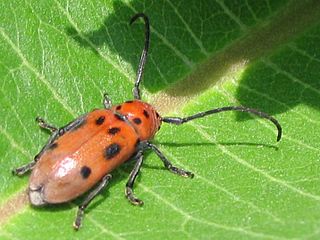Related Research Articles

Torus mandibularis is a bony growth in the mandible along the surface nearest to the tongue. Mandibular tori usually are present near the premolars and above the location on the mandible of the mylohyoid muscle attachment. In 90% of cases, a torus is on both inner sides of the mandible ; however, they may differ in size.

The red milkweed beetle is a beetle in the family Cerambycidae.
The flatjaw minnow is a species of cyprinid fish endemic to Mexico. It is considered critically endangered.

The grey-crowned tanager or grey-crowned palm-tanager is a Near Threatened species of bird in the family Phaenicophilidae, the Hispaniolan tanagers. It is endemic to the Caribbean island of Hispaniola, in both the Dominican Republic and Haiti.
Haplochromis mandibularis is a species of cichlid endemic to Lake Victoria. This species can reach a length of 17.4 centimetres (6.9 in) SL.

Ecsenius mandibularis, also known as the many-toothed blenny, Queensland combtooth blenny or Queensland blenny in Australia, is a species of combtooth blenny in the genus Ecsenius. It is found in coral reefs in the western Pacific ocean, including the southern edge of the Great Barrier Reef. It can reach a maximum length of 7.5 centimetres. Blennies in this species feed primarily off of plants, including benthic algae and weeds.

Plectroctena is an Afrotropical genus of ants, with most species occurring in the rainforest zones of West and Central Africa. Some species are cryptic or subterranean foragers, while others forage in open grassland terrain. The workers forage singly or in groups of 2 to 3. They nest in the earth at varying depths, or in collapsed logs. They prey mainly on millipedes, including their young or eggs.

Hexarthrius mandibularis is one of the world's largest stag beetle. It belongs to the tribe Lucanini, in the family Lucanidae.

Tetraopini is a tribe of longhorn beetles in the subfamily Lamiinae.

Tetraopes is a genus of longhorn beetles of the subfamily Lamiinae, tribe Tetraopini, containing the following species:
Tetraopes annulatus is a species of beetle in the family Cerambycidae. It was described by John Lawrence LeConte in 1847. It is known from the United States and Canada. Reported feeding on Asclepias sullivantii, A. subverticillata, A. speciosa, A. tuberosa, A. verticillata, A. viridiflorus.

Tetraopes femoratus is a species of beetle in the family Cerambycidae. It was described by John Lawrence LeConte in 1847. It is known from Mexico and the United States.
Tetraopes umbonatus is a species of beetle in the family Cerambycidae. It was described by John Lawrence LeConte in 1852. It is known from Nicaragua and Mexico.
Tetraopes batesi is a species of beetle in the family Cerambycidae. It was described by Chemsak in 1963. It is known from Mexico.
Tetraopes linsleyi is a species of beetle in the family Cerambycidae. It was described by Chemsak in 1963. It is known from the United States.
Tetraopes cleroides is a species of beetle in the family Cerambycidae. It was described by James Thomson in 1860. It is known from Mexico.
Tetraopes ineditus is a species of beetle in the family Cerambycidae. It was described by Chemsak and Giesbert in 1986. It is known from Mexico.
Tetraopes quinquemaculatus is a species of beetle in the family Cerambycidae. It was described by Haldeman in 1847. It is known from North America.
Tetraopes submersus is an extinct species of beetle in the family Cerambycidae. It was described by Theodore Dru Alison Cockerell in 1908. It existed in what is now the United States.
Tetraopes thermophilus is a species of flat-faced longhorn in the beetle family Cerambycidae. It is found in Central America and North America.
References
- ↑ BioLib.cz - Tetraopes mandibularis. Retrieved on 8 September 2014.